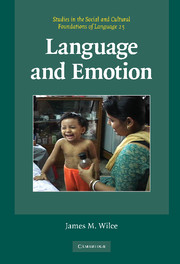Book contents
- Frontmatter
- Contents
- List of figures
- List of transcripts
- Acknowledgements
- Introduction
- Part I Theory
- 1 Defining the domain
- 2 The relationship of language and emotion
- 3 Approaches to language and emotion
- 4 The panhuman and the particular
- Part II Language, power, and honor
- Part III Identification and identity
- Part IV Histories of language and emotion
- Notes
- Glossary
- References
- Index
- STUDIES IN THE SOCIAL AND CULTURAL FOUNDATIONS OF LANGUAGE
4 - The panhuman and the particular
Published online by Cambridge University Press: 05 June 2012
- Frontmatter
- Contents
- List of figures
- List of transcripts
- Acknowledgements
- Introduction
- Part I Theory
- 1 Defining the domain
- 2 The relationship of language and emotion
- 3 Approaches to language and emotion
- 4 The panhuman and the particular
- Part II Language, power, and honor
- Part III Identification and identity
- Part IV Histories of language and emotion
- Notes
- Glossary
- References
- Index
- STUDIES IN THE SOCIAL AND CULTURAL FOUNDATIONS OF LANGUAGE
Summary
Introduction
In languages around the world, the relation of emotion to linguistic structure and practice varies in meaningful ways. This fact becomes a first-order index. As I have been arguing, first-order indexes – apparent social facts – come to us already reflected on through second-order indexes, language ideologies. And these ideologies are never innocent of power.
This chapter treats several heatedly debated topics relevant to our study. The first is: what does affirming that language and other semiotic capacities evolved with our species imply in relation to the expression of emotion? The second topic – that of the universality of particular emotions – is closely related. Discussion of this is often linked to the issue of the universality of metaphors (Kövecses 2000) by which we “gloss emotions” (Crapanzano 1992). Such discussions echo older arguments about linguistic relativity. Although typically figured in terms of “thought,” linguistic relativity has important implications for language and emotion. Here I explore Friedrich's (1986) notion of “the master trope.” Metaphors represent only a small portion of the range of tropes. Friedrich argues that there arises in every speech community (universally) a tendency to naturalize a (very particular) connection between the aesthetics of the sounds the society produces (especially in ritual moments), and the shared “mythic content” figured in its rituals. This naturalized model he calls the master trope because it influences lesser tropes speakers use. Friedrich (1986) thus offers a feeling-based or aesthetic form of linguistic relativity.
- Type
- Chapter
- Information
- Language and Emotion , pp. 67 - 84Publisher: Cambridge University PressPrint publication year: 2009

